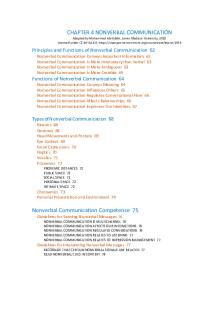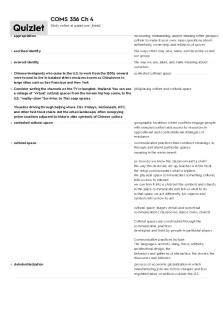Chapter 4 (Dis)Placing Culture and Cultural Space: Locations of Nonverbal and Verbal Communication PDF

| Title | Chapter 4 (Dis)Placing Culture and Cultural Space: Locations of Nonverbal and Verbal Communication |
|---|---|
| Course | Intercultural Communication |
| Institution | California State University Northridge |
| Pages | 5 |
| File Size | 107 KB |
| File Type | |
| Total Downloads | 54 |
| Total Views | 205 |
Summary
This outlines the important parts of the lectures, including definitions, examples, and theories and are actually the answers for Professor Justin Weiss's multiple choice midterm test....
Description
COMS 356 Ch 4 Study online at quizlet.com/_4ktnk2 1.
appropriation
borrowing, mishandling, and/or stealing other people's culture to make it your own; raises questions about authenticity, ownership, and relations of power
2.
ascribed identity
the ways other may view, name, and describe us and our group
3.
avowed identity
the way we see, label, and make meaning about ourselves
4.
Chinese immigrants who came to the U.S. to work from the 1850s onward were forced to live in isolated ethnic enclaves known as Chinatowns in large cities such as San Francisco and New York
contested cultural space
5.
Consider surfing the channels on the TV in bangkok, thailand. You can see (dis)placing culture and cultural space a collage of "virtual" cultural spaces from the korean hip hop scene, to the U.S. "reality-show" Survivior, to Thai soap operas. Visualize driving through beijing where T.G.I. Friday's, McDonalds, KFC, and other fast-food chains dot the urban landscape, often occupying prime locations adjacent to historic sites symbolic of Chinese culture
6.
contested cultural space
geographic locations where conflicts engage people with unequal control and access to resources in oppositional and confrontational strategies of resistance
7.
cultural space
communicative practices that construct meanings, in, through, and about particular spaces meaning in the environment ex: how do we know the classroom ain't a club? the way the desks are set up, teacher is in the front the setup communicates what is implied the physical space communicates something cultural, tells us how to interact we can turn it into a club but the symbols and objects in the place communicate and tell us what to do in that space we act differently b/c objects and symbols tell us how to act cultural space shapes verbal and nonverbal communication ( classrooms, dance clubs, church) Cultural spaces are constructed through the communicative practices developed and lived by people in particular places Communicative practices include: The languages, accents, slang, dress, artifacts, architectural design, the behaviors and patterns of interaction, the stories, the discourses and histories
8.
deindustrialization
process of economic globalization in which manufacturing jobs are lost to cheaper and less regulated labor conditions outside the U.S.
9.
(dis)placing culture and cultural space
cultural space that emerges due to global circulation of people and products, constructed by displaced, intersecting, and colliding cultures that are geographically removed from the places of origin as people and cultural products circulate globally, new cultural spaces are created, intersecting and colliding with exisiting cultural spaces, in locations often quite distant and geographically removed from the place of origin
10.
ethnic, racial, religious, sexual minority cultural groups may choose to live in communities in close proximity as a way to reinforce and maintain cultural spaces and to buffer themselves from real or perceived hostile forces around them
segregated cultural space (voluntary)
In Hurricane Katrina, low-income, working class neighborhoods were hit the hardest Gated communities 11.
glocalization
dual and simultaneous forces of globalization and localization where globalizing forces always intersect with and operate in relationship to localizing forces ex: a street in a metropolitan area in the U.S, you might find a Korean evengelical church next to an iranian bakery, and across the street, a steak house next to a thai boxing gym. how is the juxtaposition of cultural spaces we experience "here", in this particular local intercultural context, related to and interconnected with places around the globe through historic and contemporary webs of connectivity? the specific place designated "here" create a multicultural space in LA, CA this particular "here" was previously the homeland of indigenous american indians (invaded and conquered by the spanish, european colonial era) this location was inhabited by citizens of Mexico who were later displaced by the "westward movement" of white americans recent 100 years, this particular "here" was "home" to africanamericans fleeing segregation laws of the south, spatial segregation in their new home WW1, Japanese Americans, attempting to recover their dignity, economic loss, and detention in "internment camps" also made this place home
12.
How do communicative practices construct cultural space?
the physical space communicates something cultural, tells us how to interact objects in the place communicate and tell us what to do in that space we act differently b/c objects, languages, behaviors, past histories, and symbols tell us how to act Ex: silence and wearing black at a funeral
13.
How does history influence contemporary cultural spaces?
histories of interaction literally and figuratively shape and construct meanings about the ground which we stand today cultural spaces embody and materialize webs of connectivity across both space and time
14.
How does space (human made environment) reflect and construct culture?
Cultural spaces are constructed through the communicative practices developed and lived by people in particular places "where you're from" communicates meaning about your identity, class status, power positions, and history ex:
15.
How does the history of hip hop culture illustrate the concept of cultural space, the relationship between place and power and location of enunciation?
concept of cultural space: African tribal rhythms and music traditions that survived through transportation to the Americas and 300 years of slavery; rapping grew fromits roots of tribal chants and plantation work songs (black resistance to oppressive white society); break-dancing, graffitti, protest of assimilation to white society, soul, funk blues relationship between place and power: as hip hop grew into mainstream society, it brought a power it enables economic mobility and provides a platform for speaking. It also promotes stereotypes about communities of color and valorizes danger, violence, misogyny and homophobia. location of enunciation: the bronx on the 1970s was an urban wasteland. NY had been devastated by the loss of jobs due to deindustrialization, bronx was left out of the revitilization program, heavily unemployed, poverty-stricken, slumlords, it provides communication vehicles for the marginalized
16.
How is identity connected to place?
where you come from translates and communicates meaning about your identity, class, power positions, and history (ascribed identity) however the way people who live in one place talk about and make meaning about their identity and their "home" (avowed)
17.
18.
How is space/place marked by culture, class, and sometimes by race and gender?
Cultural spaces are constructed through the communicative practices developed and lived by people in particular places
hybrid cultural space
DEF 1: the intersection of intercultural communication practices that construct meanings in, through, and about places within a context of relations of power
ex: compton => jim crow laws
ex: McDonald's in India, geographical location hybrid, business is blended DEF 2: an innovative and creative space where people constantly adapt to negotiate with and improvise between multiple cultural frame works ex: asian indian immigrants in the US adapt 19.
hybrid cultural space as sites of intercultural negotiation
hybrid cultural spaces as innovative and creative spaces where people constantly adapt to, negotiate with, and improvise between multiple cultural frameworks
20.
hybrid cultural space as sites of resistance
hybrid cultural space where people challenge stable, territorial, and static definitions of culture, cultural spaces, and cultural identitites
21.
hybrid cultural space as sites of transformation
hybrid cultural space were hegemonic structures are negotiates and reconfigured through hybridization of culture, cultural space, and identities
22.
imagine walking through the narrow spanish colonial streets in "Old Town" San Juan, Puerto Rico, and stepping through the doorway of Tantra, a restaurant that serves a delicious fusion of Latin and Indian food to tourists and locals while a Puerto Rico woman dances.
(dis)placing culture and cultural space
23.
"in-hereness"
boundaries that separate people, "in here", with you and your culture, "out there", the other, outside your culture ex: reseda and porter ranch "in here" => perspective about ppl who live in reseda think about that the people of porter ranch are bougie, stuck up "out there" => porter ranch people think that the reseda people are ghetto and broke
24.
In the early 2000s, in Hudson, New York, a small town of 7,000 just 100 miles north of New York City, residents joined together to protest the building of a massive, coal-fired cement factory
contested cultural space
25.
locations of enunciation
literal and figurative sites or positions from which to speak
26.
"out-thereness"
characteristic of globalization where places around the world, out "there", are linked to particular locations "here" and how this linkage reveals colonial histories and postcolonial realities
27.
polysemic cultural space
condition in which multiple meanings are constructed about certain places, people, and phenomena EX: chinatown, was originally seen as a place ot exclude and isolate chinese immigrants by white city power brokers. seen and experienced as a safe haven, "home" for chinese immigrants
28.
segregated cultural space
segregated spaces based on socioeconomic, racial, ethnic, sexual, political, and religious differences both voluntary and imposed
29.
time-space compression
characteristic of globalization that brings seemingly disparate cultures into closer proximity, intersection, and juxtaposition with each other time and space are experienced as compressed due to increasingly rapid communication and transportation tech ex: as time needed for people and messages to travel across distances is shortened physically through air travel and representationally through electronically mediated communication, time and space are condensed we experience time-space compression as people, media,money, and ideas move more frequently and rapidly today
30.
What is de-territorialization? Re-territorialization of culture and cultural space?
de-territorialization of culture and cultural space (uprooted from situatedness): hip hop culture was uprooted from the urban centers in the U.S. Re-territorialization of culture and cultural space(relocated in new): and rerooted in new locations such as latin america, europe, asia, creating hybrid cultural spaces
31.
What is the relationship between place and power?
Power is signified, constructed and regulated through size, shape, access, containment and segregation of space ex: churches were the tallest building in the Middle ages and occupied central locations it cities signifying the importance of religious authority
32.
The word "ghetto" originally referred to an area in Venice, Italy where Jews were segregated and required to live in the 1500s. The reservation system imposed on Native Americans. The Jim Crow laws (1865-1960s) that segregated Blacks.
segregated cultural space (involuntary)...
Similar Free PDFs

Chapter 4 Nonverbal Communication
- 19 Pages

Chapter 8 Culture and Communication
- 20 Pages

6 - Nonverbal Communication
- 1 Pages
Popular Institutions
- Tinajero National High School - Annex
- Politeknik Caltex Riau
- Yokohama City University
- SGT University
- University of Al-Qadisiyah
- Divine Word College of Vigan
- Techniek College Rotterdam
- Universidade de Santiago
- Universiti Teknologi MARA Cawangan Johor Kampus Pasir Gudang
- Poltekkes Kemenkes Yogyakarta
- Baguio City National High School
- Colegio san marcos
- preparatoria uno
- Centro de Bachillerato Tecnológico Industrial y de Servicios No. 107
- Dalian Maritime University
- Quang Trung Secondary School
- Colegio Tecnológico en Informática
- Corporación Regional de Educación Superior
- Grupo CEDVA
- Dar Al Uloom University
- Centro de Estudios Preuniversitarios de la Universidad Nacional de Ingeniería
- 上智大学
- Aakash International School, Nuna Majara
- San Felipe Neri Catholic School
- Kang Chiao International School - New Taipei City
- Misamis Occidental National High School
- Institución Educativa Escuela Normal Juan Ladrilleros
- Kolehiyo ng Pantukan
- Batanes State College
- Instituto Continental
- Sekolah Menengah Kejuruan Kesehatan Kaltara (Tarakan)
- Colegio de La Inmaculada Concepcion - Cebu












